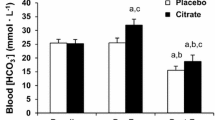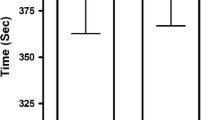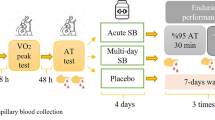Abstract
We examined the effects of sodium bicarbonate (BIC) and sodium citrate (CIT) ingestion on distance running performance. Seven male runners [mean\(\dot VO_{2max}\) = 61.7 (SEM 1.7) ml · kg−1 · min−1] performed three 30-min treadmill runs at the lactate threshold (LT) each followed by a run to exhaustion at 110% of LT. The runs were double-blind and randomly assigned from BIC (0.3 g · kg body mass−1), CIT (0.5 g · kg body mass−1) and placebo (PLC, wheat flour, 0.5 g · kg body mass−1). Venous blood samples were collected at 5, 15 and 25 min during the run and immediately post-exhaustion (POST-EX) and analysed for pH, and the concentrations of lactate ([1a−]b) and bicarbonate ([HCO3 − ]). Performance was measured as running time to exhaustion at 110% of LT (TIME-EX). The pH was significantly higher (P ≤ 0.05) for the BIC and CIT trials during exercise, but not POST-EX compared to PLC. The [1a−]b was significantly higher (P ≤ 0.05) for the CIT trial compared to PLC during exercise, and for both CIT and BIC compared to PLC at POST-EX. Blood [HCO3 −] was significantly higher (P ≤ 0.05) during exercise for BIC compared to PLC. TIME-EX was not significantly different among treatments: BIC 287 (SEM 47.4) s; CIT 172.8 (SEM 29.7) s; and PLC 222.3 (SEM 39.7) s. Despite the fact that buffer ingestion produced favourable metabolic conditions during 30 min of high intensity steady-state exercise, a significant improvement in the subsequent maximal exercise run to exhaustion did not occur.
Similar content being viewed by others
References
Bouissou P, Defer G, Guezennec C, Estrade P, Serrurier B (1988) Metabolic and blood catecholamine responses to exercise during alkalosis. Med Sci Sports Exerc 20:228–232
Caldwell P (1958) Studies of the internal pH of large muscle and nerve fibers. J Physiol 142:22–62
Coombes J, McNaughton L (1993) Effects of bicarbonate ingestion on leg strength and power during isokinetic knee flexion and extension. J Strength Cond Res 7:241–249
Costill D, Verstappen F, Kuipers H, Jansson E, Fink W (1984) Acid-base balance during repeated bouts of exercise: influence of HCO3 −. Int J Sports Med 5:228–231
Daniels J, Daniels N (1992) Running economy of elite male and elite female runners. Med Sci Sports Exerc 24:483–489
Forster H, Dempsey J, Thompson J, Vidruk E, doPico G (1974) Estimation of arterial PO2, PCO2, pH and lactate from arterialized venous blood. J Appl Physiol 32:134–137
George K, MacLaren D (1988) The effect of induced alkalosis and acidosis on endurance running at an intensity corresponding to 4 mM blood lactate. Ergonomics 31:1639–1645
Goldfinch J, McNaughton L, Davies P (1988) Induced metabolic alkalosis and its effects on 400-m racing time. Eur J Appl Physiol 57: 45–48
Hawk P (1965) Gastric digestion and analysis. In: Oser BL (ed) Hawk's physiological chemistry. McGraw-Hill, New York, 466–488
Heigenhauser G, Jones N (1991) Bicarbonate loading. In: Lamb DR, Williams MH (eds) Perspectives in exercise science and sports medicine. Brown, Dubuque, pp 183–212
Hooker S, Morgan C, Wells C (1987) Effect of sodium bicarbonate ingestion on time to exhaustion and blood lactate of 10k runners. Med Sci Sports Exerc 19:S67
Jones N, Sutton J, Taylor R, Toews C (1977) Effect of pH on cardiorespiratory and metabolic responses to exercise. J Appl Physiol 43:959–964
Jorgensen I, Astrup C (1957) Standard bicarbonate, its clinical significance, and a new method for its determination. Scand J Clin Lab Invest 9:122
Kowalchuk J, Maltais S, Yamaji K, Hughson R (1989) The effect of citrate loading on exercise performance, acid-base balance and metabolism. Eur J Appl Physiol 58:858–864
Mainwood G, Worsley-Brown P (1975) The effects of extracellular pH and buffer concentration on the efflux of lactate from frog sartorius muscle. J Physiol 250:1–22
Mainwood G, Renaud J (1985) The effect of acid-base balance on fatigue of skeletal muscle. Can J Physiol Pharmacol 63:403–416
McKenzie D, Coutts K, Stirling D, Hoeben H, Kuzara G (1986) Maximal work production following two levels of artificially induced metabolic alkalosis. J Sport Sci 4:35–38
McNaughton L (1990) Sodium citrate and anaerobic performance: implications of dosage. Eur J Appl Physiol 61:392–397
McNaughton L, Cedaro R (1992) Sodium citrate ingestion and its effects on maximal anaerobic exercise of different durations. Eur J Appl Physiol 64:36–41
Mitchell T, Abraham G, Wing S, Magder S, Cosio M, Deschamps A, Marliss E (1990) Intravenous bicarbonate and sodium chloride both prolong endurance during intense cycle ergometer exercise. Am J Med Sci 300:88–97
Parry-Billings M, McLaren D (1986) The effect of sodium bicarbonate and sodium citrate ingestion on anaerobic power during intermittent exercise. Eur J Appl Physiol 55:524–529
Roth D (1991) The sarcolemmal lactate transporter: transmembrane determinants of lactate flux. Med Sci Sports Exerc 23:925–934
Roth D, Brooks G (1990) Lactate and pyruvate transport is dominated by a pH gradient-sensitive carrier in rat skeletal muscle sarcolemmal vesicles. Arch Biochem Biophys 279:386–394
Rupp J, Bartels R, Zueter W, Fox E, Clark R (1983) Effect of sodium bicarbonate ingestion on blood and muscle pH and exercise performance. Med Sci Sports Exerc 15:115
Siggard-Anderson O (1974) The acid-base status of the blood 4th edn. Williams and Wilkins, Baltimore, MD pp 37
Siggaard-Anderson O, Engel K (1960) Nomogram for the determination of acid-base status. Scand J Clin Lab Invest 12:177–186
Sutton J, Jones N, Toews C (1976) Growth hormone secretion in acid-base alterations at rest and during exercise. Clin Sci 50:241–247
Sutton J, Jones N, Toews C (1981) Effect of pH on muscle glycolysis during exercise. Clin Sci 61:331–339
Webster M, Webster M, Crawford B, Gladden L (1993) Effect of sodium bicarbonate ingestion on exhaustive resistance exercise performance. Med Sci Sports Exerc 25:960–965
Wijnen S, Verstappen F, Kuipers H (1984) The influence of intravenous NaHCO3 − administration on interval exercise: acid-base balance and endurance. Int J Sports Med 5:130–132
Wilkes D, Gledhill N, Smyth R (1983) Effect of acute induced metabolic acidosis on 800m racing time. Med Sci Sports Exerc 15:277–280
Author information
Authors and Affiliations
Rights and permissions
About this article
Cite this article
Potteiger, J.A., Webster, M.J., Nickel, G.L. et al. The effects of buffer ingestion on metabolic factors related to distance running performance. Europ. J. Appl. Physiol. 72, 365–371 (1996). https://doi.org/10.1007/BF00599698
Accepted:
Issue Date:
DOI: https://doi.org/10.1007/BF00599698




